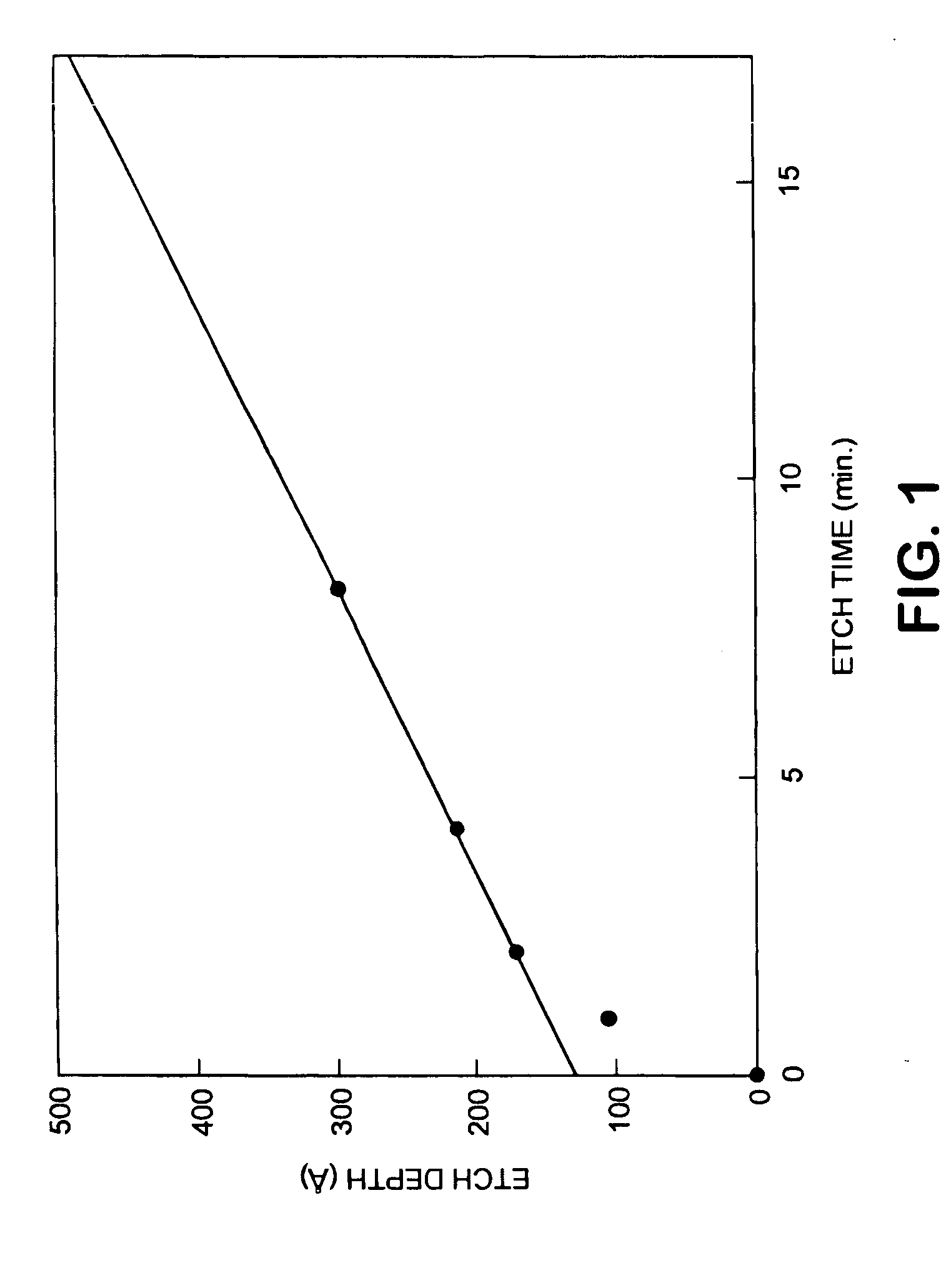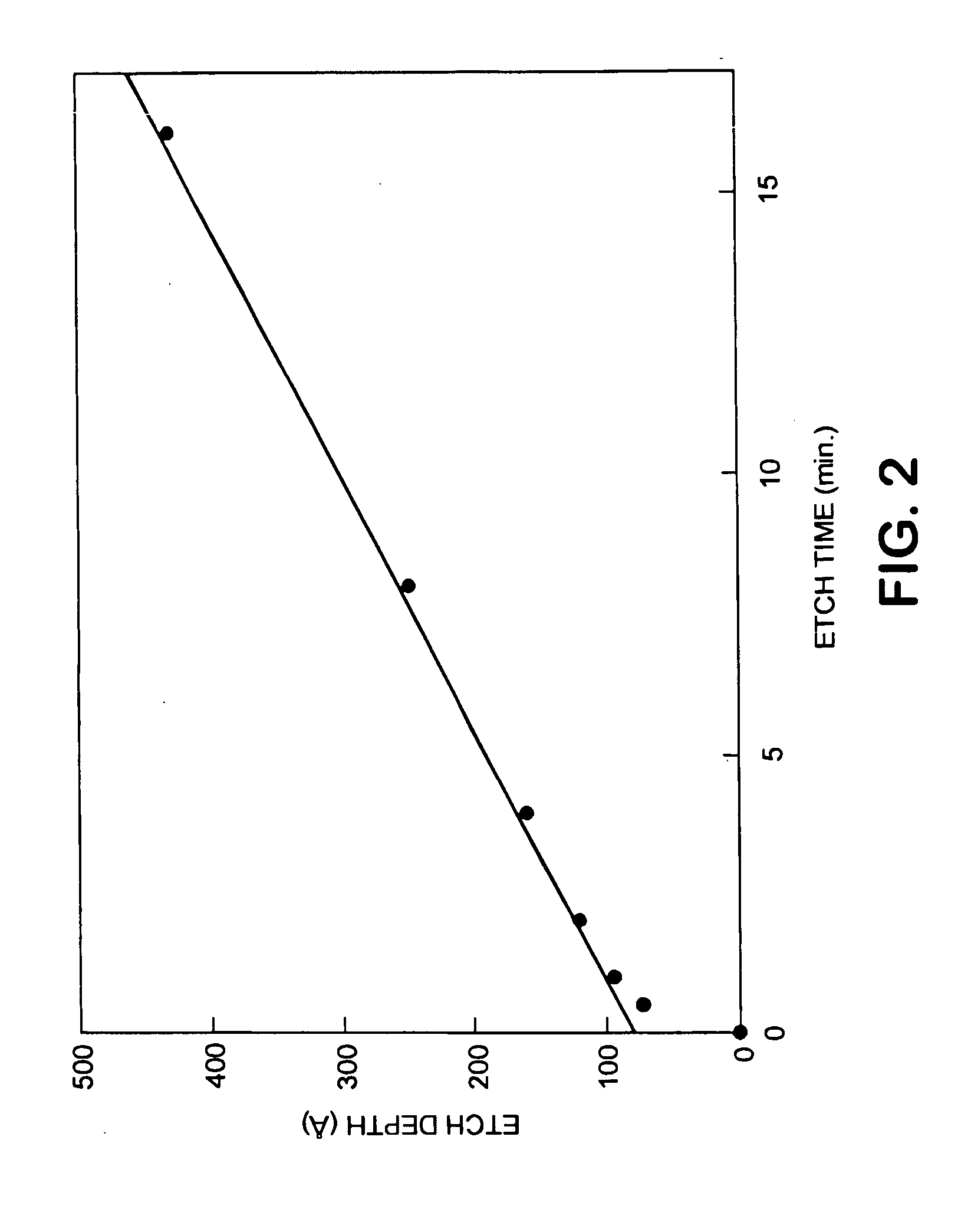Method for isotropic etching of copper
- Summary
- Abstract
- Description
- Claims
- Application Information
AI Technical Summary
Benefits of technology
Problems solved by technology
Method used
Image
Examples
example 1
[0068] An interconnect copper structure, which includes a dielectric and a liner inert to the etchant and containing 1 and 0.1 micron wide wires, was first cleaned with a deaerated isopropanol / HCl mixture (25% IPA, 0.18% HCl) to remove any contaminants from the preceding CMP (chemical-mechanical polishing) step, and then was etched for about 4 minutes at room temperature in an etchant of this invention (an aqueous solution containing 2.94 wt % H2O2, 0.54% NH3, and 0.05% CDTA and a pH of approximately 10.2). During the etching the sample was stationary in a beaker and the solution was stirred with a 2.5 cm magnetic stirring bar at 180 rpm. The sample was then dried in a nitrogen stream. The inhibiting layer was then removed by treating the sample for about 4 minute with a nitrogen-deaerated 100:1 (v / v) acetic acid solution.
[0069] This example illustrates the steps of inhibiting layer formation and dissolution with respect to effects on copper recessing. See FIGS. 4, 5 and 6 which sh...
example 2
[0073] A substrate similar in type to the one used in Example 1, was cleaned as described above and then was etched for 8 minutes in the same etching solution as used in Example 1 and under the same conditions as above. The inhibiting layer was immediately removed by treating the sample for about 2 minutes with a nitrogen-deaerated mixture of 0.2 Molar sulfuric acid and 0.2 Molar acetic acid.
[0074] This example demonstrates the possibility of deeper recesses which in turn shows that the etch according to the present invention is not self limiting as is the known art. This example also demonstrates that the present invention make possible smoother copper recesses than typical etchants as, for instance, exemplified in example 3 below.
[0075] The results are shown in FIG. 7. FIG. 7 is an AFM image of a 3×5 micron copper pad imbedded in a dielectric after processing with CMP and IPA / HCl clean, followed by an 8 minute etch according to the present invention and the as acid removal of th...
example 3
[0076] A sample similar in type to the one used in example 2 was etched in a standard Cu etch (H2O:H2O2 30%: acetic acid 1000:3:5 v / v). The average depth of the copper below the dielectric surface is about 54 nanometers. Note the roughness that occurs due to the non-uniform copper removal (AFM surface topograph, FIG. 8) as compared to the smooth copper surface achieved by the present invention (see FIGS. 6 and 7).
PUM
| Property | Measurement | Unit |
|---|---|---|
| Thickness | aaaaa | aaaaa |
| Molar density | aaaaa | aaaaa |
| Molar density | aaaaa | aaaaa |
Abstract
Description
Claims
Application Information
 Login to View More
Login to View More - Generate Ideas
- Intellectual Property
- Life Sciences
- Materials
- Tech Scout
- Unparalleled Data Quality
- Higher Quality Content
- 60% Fewer Hallucinations
Browse by: Latest US Patents, China's latest patents, Technical Efficacy Thesaurus, Application Domain, Technology Topic, Popular Technical Reports.
© 2025 PatSnap. All rights reserved.Legal|Privacy policy|Modern Slavery Act Transparency Statement|Sitemap|About US| Contact US: help@patsnap.com



